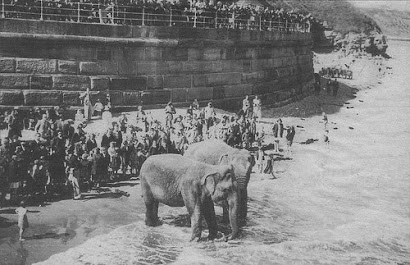Unlike today's throwaway culture, all the parts of the whale's body were utilised. The shape of the jaw bones meant that they could be pressed into service as roof supports or crucks for buildings without being refashioned. Indeed the new Whitby Marina Facilities Centre imitates this iconic shape using modern materials.
.jpg)
 These two pictures from the 1930s show what was Moorsom's warehouse, under the shadow of Ruswarp viaduct. The structure is being dismantled and broken whalebones can be seen in the foreground. The roof was probably made from the canvas of reclaimed sails stretched across the bones. It is said that somewhere a photograph exists from inside the shed with the roof intact.
These two pictures from the 1930s show what was Moorsom's warehouse, under the shadow of Ruswarp viaduct. The structure is being dismantled and broken whalebones can be seen in the foreground. The roof was probably made from the canvas of reclaimed sails stretched across the bones. It is said that somewhere a photograph exists from inside the shed with the roof intact.Liverpool was home to a similar shed and the roof of the blubberhouse at King's Lynn was supported by 13 upright jawbones. It is also said that the Victorians had a penchant for building summerhouses from them.
...
In the Beck Isle Museum at Pickering is a pair of whalebones which originally stood as an arch at the entrance to a field in Swainsea Lane. They were brought to the town by Nicholas Piper, a whaling captain who lived in Pickering and sailed from Whitby.



No comments:
Post a Comment